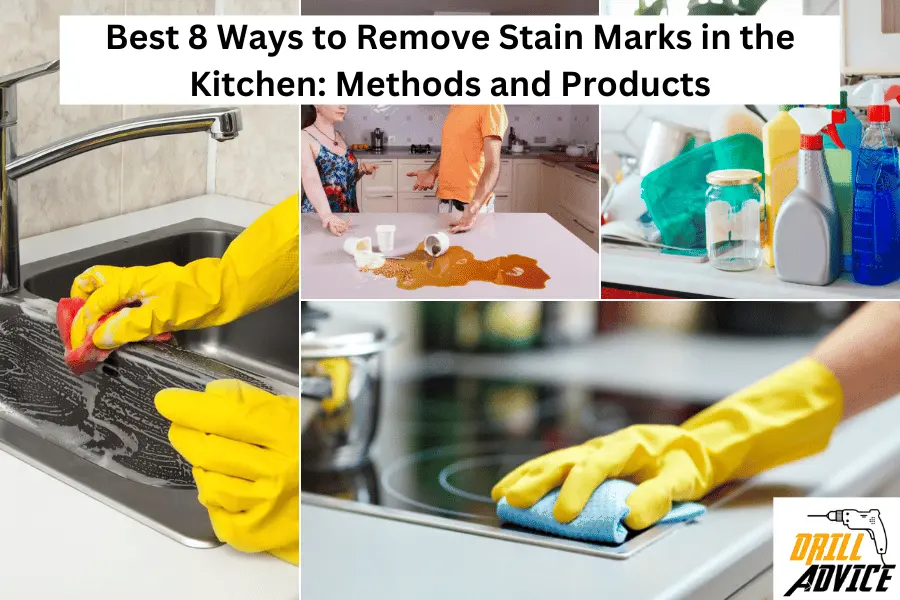
Stain marks in the kitchen is a serious problem to the kitchen. Stain marks can damage the aesthetic view of the kitchen. Stain marks can occur on the kitchen countertops, furniture, appliances, tiles, cooktops, clothes, storage, and equipment. These stain marks are mainly 11 types.
Those are grease and oil, food spills and splatters, coffee and tea, wine and juice, sauce and food residue, mold and mildew, ink and marker, burn marks, food dyes, and rust. These stain marks are not dissolved in the water. Therefore those remain on the surfaces. By applying the below 8 stain-removing liquids and paste, these stain marks can be removed easily.
You can use these liquids and paste to remove the stain marks in the kitchen, such as hydrogen peroxide, baking soda, white vinegar, lemon juice, dish soap, salt, cornstarch, and oxygen bleach.
After applying the stain removers, you have to remain 10-15 mins to soake on the surface. After that you can wash or wipe the surface. But before applying the below stain removers, you should make sure that the remover is not react with the surface.
What are the 11 Types of Stain Marks in The Kitchen?

Different stains occur in the kitchen due to different kitchen activities. These are the most common 11 types of stain marks in the kitchen.
- Grease and Oil Stains: Grease and Oil Stains can occur due to cooking oils, butter, and other fats can leave behind greasy marks.
- Food Spills and Splatters: Liquid food spills such as sauces, soups, gravies, or sweets can stain counters, tables, walls and even clothes.
- Coffee and Tea Stains: Coffee and tea spills also can stain countertops, tables, mugs, and kitchen lines.
- Wine and Juice Stains: Colorful beverages, such as red wine and grape juice, can stains on surfaces, dishware, and clothes.
- Sauce and Food Residue: Sauces, gravies, and food residue tend to stick to cooking utensils and cooking surfaces.
- Mold and Mildew Stains: In areas with high moisture can lead to stubborn stains. Such as; around sinks or in refrigerator gaskets, mold and mildew..
- Ink and Marker Stains: In kitchens ink or marker stains might appear on countertops, walls, or even fabrics. Those stains can double the creative spaces.
- Burn Marks: Accidental burns can cause discoloration or marks on surfaces..
- Food Dyes: Colored foods, such as berries or certain spices, can sometimes make stains on various surfaces and fabrics.
- Rust Stains: Rust can appear on metal items in the kitchen.
How to Remove Stain Marks in the Kitchen?
Due to different kitchen activities, stain marks can occur on the surface of the countertops, appliances, furniture and clothes. These stain marks should be removed with the stain-removing compound. These are the common 6 steps to remove stain marks in the kitchen.
Step 01 – Prepare the Stain Mark Removing Solution: Mix the stain mark removal solution according to the recommended proportions and ingredients.
Step 02 – Apply the Stain Mark Solution: Spray or dab the solution directly onto the stain mark. You can use clean cloth or sponge to apply it to the stain.
Step 03 – Let It Absorb: Allow the solution to sit on the stain for about 5 to 10 minutes to penetrate and break down the stain.
Step 04 – Scrub or Wipe: After the soaked period, gently scrub or wipe the stained area. The acidity of the solution loosened and dissolved the stain particles..
Step 05 – Rinse and Remove: Rinse the scrubbed area thoroughly with clean water to remove any remaining.
Step 06 – Repeat if Necessary: Depending on the severity of the stain, repeat the process if the stain persists. The solution can allow for a longer period before scrubbing to remove the stubborn stains.
Read More About
- Kitchen Waste Management: Types, Collecting and Disposal
- 7 Ways to Remove Cooking Odors in the Kitchen: Ingredients and Methods
- 7 Types of Kitchens: Efficiency, Layout, Space, Storage, and Cost
What are the 8 Ways to Remove Stain Marks in the Kitchen?
Stain marks in the kitchen is a common problem in the kitchen. These stain marks are not soluble in water. Therefore you should use specific liquids and paste to remove the stain marks in the kitchen. Before you apply the liquid or paste, you should know its impact and reaction with the surface. Because some stain removers consist of bleaching agents and it will damage the aesthetic appeal of the material. These are the most used 9 stain removers in the kitchen.
1. Use Hydrogen Peroxide to Remove Stain Marks
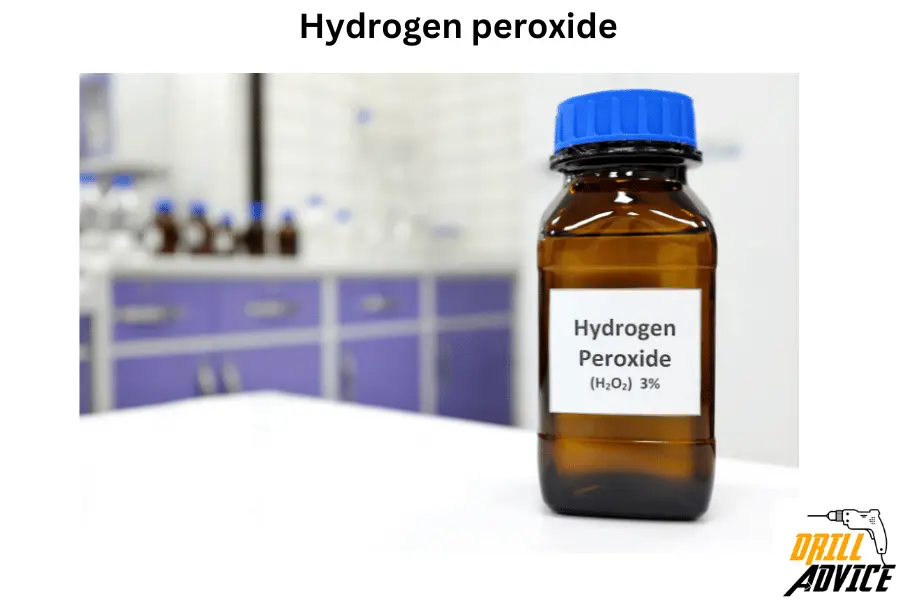
Certainly, let me provide you with detailed instructions on using hydrogen peroxide to remove stain marks in the kitchen.
Hydrogen peroxide is a colorless liquid with strong oxidizing properties. It can be used alone or mixed with a small amount of baking soda to make a paste.
Leave the hydrogen peroxide solution or paste it on the stain for 10 to 15 minutes. During this time, the hydrogen peroxide effectively breaks down the components of the stain.
Types of stain can be removed: Hydrogen peroxide is a versatile stain remover. Accordingly, the most common types of stain marks that can be removed;
- Food Stains – Grease, sauces, and food splatters.
- Beverage Stains – Coffee, tea, and colorful juices.
- Mold and Mildew Stains – Specially on tile grout or silicone seals.
- Blood Stains – Can remove the small stains.
- General Discoloration – Hydrogen peroxide can also reduce mild discoloration of surfaces caused by wear and tear.
Note: Hydrogen peroxide can be a bit of a bleaching agent. Therefore: doing a patch test on a small, inconspicuous area before using it on a larger stain is a better step. This is especially important for colored fabrics or surfaces.
The Hydrogen peroxide, as a paste, can be created by mixing hydrogen peroxide with a small amount of baking soda. The baking soda adds a gentle abrasive element to the cleaning and removal of the stain process.
2. Use Baking Soda Paste to Remove Stain Marks

The baking soda paste is created by combining baking soda and water. This mixture forms a paste that has both gentle abrasiveness and cleaning properties. It helps to remove various stain marks in kitchen appliances and surfaces.
Baking soda paste should remain on the stain mark for about 10 to 15 minutes. This gives it enough time to work on breaking down the stain particles.
Using Baking Soda, you can remove these stain marks, such as,
- Grease and Oil Stain marks on the countertops: From cooking surfaces, oven interiors, and appliances.
- Food Residue and Spills on the table: Such as tomato sauce, coffee, tea, and other spills on countertops, sinks, and tables.
- Scuff Marks on the walls: On various surfaces like walls or floors.
3. Use White Vinegar to Remove Stain Marks
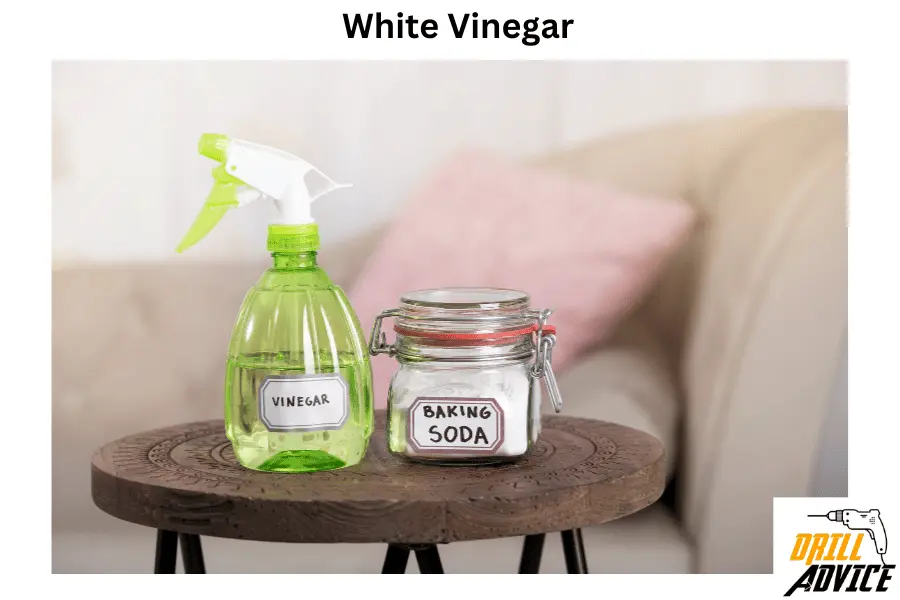
The white vinegar is a combination of white vinegar and water. This diluted vinegar removes stains efficiently, ensuring safe application on a variety of surfaces.
White vinegar solution should remain on the stain mark for about 5 to 10 minutes. This gives vinegar’s natural acidity enough time to work on breaking down the stain particles.
Using White vinegar solution, you can remove these stain marks, such as,
- Grease and Oil Stain marks on the countertops: From cooking surfaces, stove tops, and appliances.
- Mineral Deposits on the Sink: .In addition to; on the faucet and glasswares.
- Coffee and Tea stains on the Porcelain Items: Mugs, teapots, and countertops.
- Food Spills and Splatters on countertops: In addition to; tables and kitchen appliances.
4. Use Lemon Juice to Remove Stain Marks
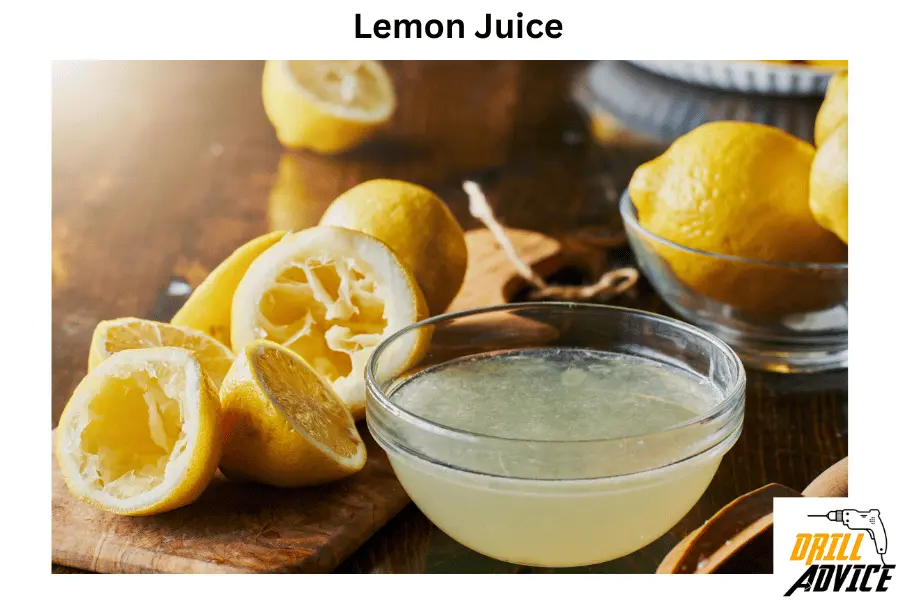
Lemon juice is a natural acid. It helps to remove stain marks in the kitchen. You can use freshly squeezed lemon juice or pre-packaged lemon juice as a stain remover. Lemon juice with a small amount of salt or baking soda can increase the stain removal efficiency.
Lemon juice should remain on the stain mark for about 5 to 10 minutes. This gives lemon juice natural acidity enough time to work on breaking down the stain particles.
Using lemon juice, you can remove these stain marks, such as,
- Grease and Oil Stain marks: From cooking surfaces, stove tops, and appliances.
- Food Stains and Residue: Such as; tomato sauce, coffee, tea, and other spills on countertops, sinks, and tables.
- Mineral Deposits on the Sink: .In addition to; on the faucet and glasswares.
- Surface Discoloration: Lemon juice can help lighten mild discolorations on wear.
5. Use Dish Soap to Remove Stain Marks
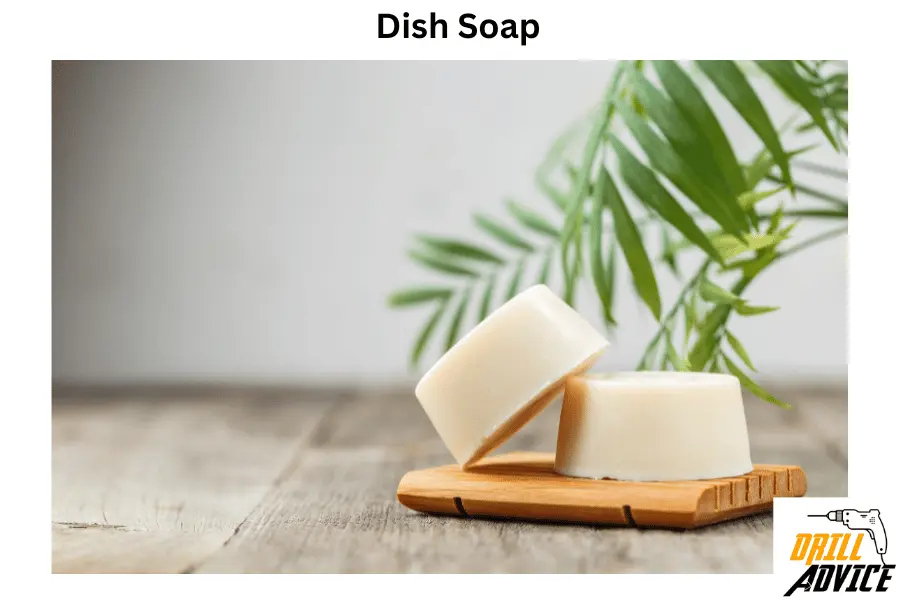
A dish soap solution is a combination of dish soap and warm water. Dish soap water is a valuable stain-removing agent
Dish soap solution should remain on the stain mark for about 10 to 12 minutes. This gives enough time to work on breaking down the stain particles.
Using dish soap solution, you can remove these stain marks;
- Grease and Oil Stains on the cooking surfaces: Stovetops and other kitchen appliances.
- Food Spills and Splatters: On countertops, tables, and appliances.
- Coffee and Tea Stains on the Porcelain Items: Mugs, teapots, and countertops.
- Sauce and Food Residue on the cooking pots and pans
6. Use Salt to Remove Stain Marks

The plain salt can be used as a natural abrasive that helps to lift stains. It can be used as a solution or a paste. The paste can include lemon juice or water with salt in order to improve the stain-removing ability.
Salt solution or the paste should remain on the stain mark for about 5 to 10 minutes. This gives enough time to work on breaking down the stain particles.
Using dish soap solution, you can remove these stain marks;
- Grease and Oil Stains on the cooking surfaces: Stovetops and other kitchen appliances.
- Food Spills and Splatters: On countertops, tables, and appliances.
- Coffee and Tea Stains on the Porcelain Items: Mugs, teapots, and countertops.
- Rust Stains on metal surfaces
7. Use Cornstarch to Remove Stain Marks
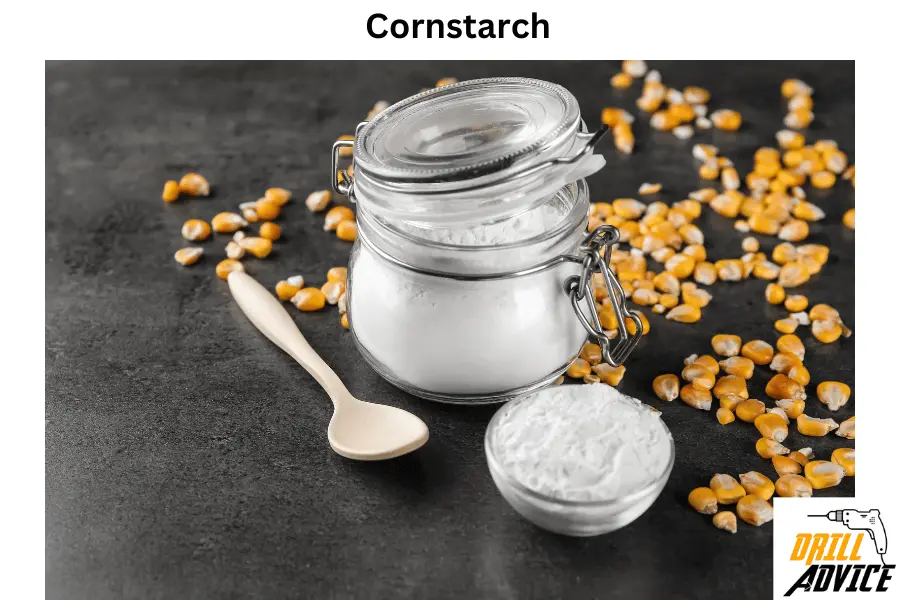
The cornstarch is a fine powder and it has absorbent properties. It can be used on its own or as a paste. The cornstarch can be used with water as a paste to remove the stains in the kitchen.
Corn starch should remain on the stain mark for about a few hours or even overnight. This extended time need to work on stain and moisture effectively.
Using corn starch, you can remove these stain marks;
- Grease and Oil Stains on the cooking surfaces: Stovetops and other kitchen appliances.
- Food Spills and Splatters: On countertops, tables, and appliances.
8. Use Oxygen Bleach to Remove Stain Marks
.
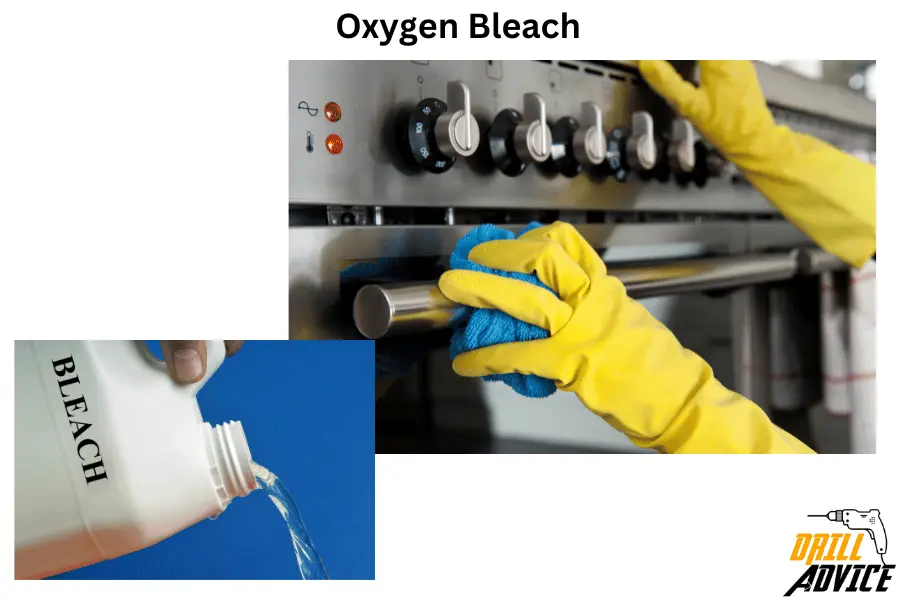
Oxygen bleach or color-safe bleach is a powerful and non-toxic cleaning agent for kitchen stain removal. It releases oxygen molecules to break down stains and dirt. The oxygen bleach powder or solution must be mixed with water to create the cleaning solution.
The Oxygen bleach solution should remain on the stain mark for about 15 to 30 minutes. This time is enough to work on stains.
Using Oxygen bleach, you can remove these stain marks;
- Food Stains and Grease on the CookingSurfaces: stovetops and other cooking appliances.
- Coffee and Tea Stains of the porcelain items: Cups, mugs, and other surfaces.
- Food Spills and Splatters: On countertops, tables, and appliances.
- Mold and Mildew Stains on the Moisture-Prone Areas: On tile grout, silicone seals.
